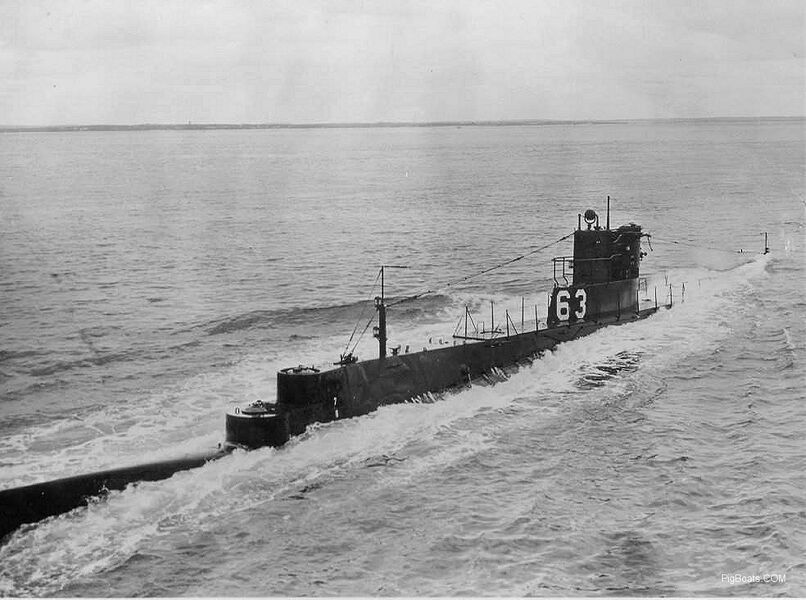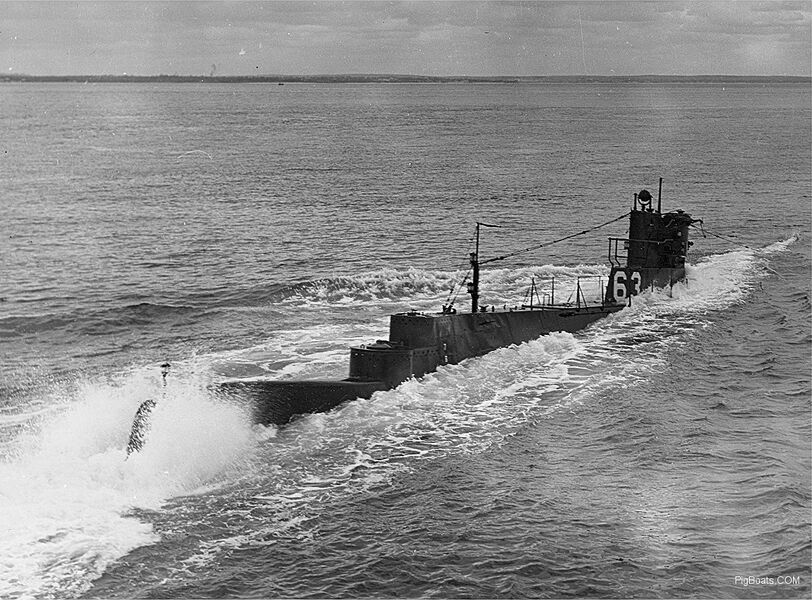O-2: Difference between revisions
Pbcjohnston (talk | contribs) (Added captions) |
Pbcjohnston (talk | contribs) (Added captions) |
||
| Line 55: | Line 55: | ||
[[File:O-2 in water.jpg|left|500px]] | [[File:O-2 in water.jpg|left|500px]] | ||
O-2 in the water three days after her launching at the Puget Sound Navy Yard, May 27, 1918. Here the final phase of construction, called "fitting out", will begin. The stern is to the left in the photo and bow to the right. Her stern is still light due her not having shafts, props or rudders or stern planes. Her bow is still missing the superstructure plating and bow cap. On the top of the hull can be seen her main induction piping to bring air to her diesel engines, to the left of the gangway plank. The conning tower is to the right of the gangway. | |||
<small>U.S. Navy photo.</small> | |||
[[File:Red bar sub new.jpg]] | |||
[[File:O-2 crest.jpg|left|500px]] | [[File:O-2 crest.jpg|left|500px]] | ||
Retired CAPT. William C. Eddy sent this information to Ric Hedman: | |||
''Back in 1922, I was on the Naval Academy Class Crest Committee and, using a "bows on" photo of the submarine O-2 and adding two dolphins rampant, I came up with a design of the '26 class crest. About two years later, George Meale of Bailey, Banks and Biddle, mentioned that the submarine service was looking for a design for "Submarine Wings" to denote qualification in Submarines. Using my original sketches of the '26 crest, and flattening out the dolphins, we came up with the present submarine insignia which was adopted by the Navy. George gave me what was purported to be the first dolphins struck from the dies, which I gave to my mother. I was very proud to reclaim those original dolphins after qualifying in the 35 boat (i.e. [[S-35|'''S-35 (SS-140)''']]). The class might be interested in the tie-in between the '26 crest, the O-2, and the present Dolphins.'' | |||
<small>Logo in the private collection of Ric Hedman.</small> | |||
[[File:Red bar sub new.jpg]] | |||
[[File:O-2 and v-4 at dry dock.jpg|left|500px]] | [[File:O-2 and v-4 at dry dock.jpg|left|500px]] | ||
O-2 and the [[V-4|'''V-4 (SM-1)''']] in dry dock at the Portsmouth Navy Yard, March 29, 1928. The dry dock is flooding through openings in dry dock doors, at the rear. The huge difference in size between the coastal patrol submarine O-2 and the globe spanning minelayer V-4 is dramatically illustrated here. Only ten years separated their construction. | |||
<small>U.S. Navy photo.</small> | |||
[[File:Red bar sub new.jpg]] | |||
[[File:O-2 surfacing.jpg|left|500px]] | [[File:O-2 surfacing.jpg|left|500px]] | ||
An action shot of O-2 surfacing at the end of a submerged run somewhere in the western Atlantic during WWII. | |||
<small>U.S. Navy photo.</small> | |||
[[File:Red bar sub new.jpg]] | |||
[[File:O-2 surface at speed.jpg|left|500px]] | |||
O-2 running on the surface, possibly at the mouth of the Thames River in Connecticut, during the WWII years. O-2 was serving as a training boat for Submarine School students at the base in Groton. | |||
<small>U.S. Navy photo.</small> | |||
[[File: | [[File:Red bar sub new.jpg]] | ||
<center> | |||
<gallery mode="packed" widths="500px" heights="400px"> | |||
File:O-2 diving.jpg|<small>U.S. Navy photo.</small> | |||
File:O-2 diving2.jpg|<small>Photo 80-G-43874 via NHHC and NARA.</small> | |||
</gallery> | |||
</center> | |||
<div style="text-align: justify;"><span style="color:#00008B">A two photo sequence of O-2 diving, approximately 1943. Location is not known for sure, but it may be the measured mile off Provincetown, Cape Cod, Massachusetts. In the second photo, the down angle of the boat is such that the whirling propellers are breaking the surface and kicking up spray. The fact that this happened on a training submarine is not surprising. On an operational submarine in the war zone, sticking the props out of the water is not desired because is slows the diving process. The stern planesman has to be experienced enough to prevent this from happening. | |||
[[File:Red bar sub new.jpg]] | |||
[[File:O-2 diving3.jpg|left|500px]] | |||
O-2 surfacing after the dive shown in the photos above. To surface, the auxiliaryman in the control room would blow the forward and after group ballast tanks using high pressure air. The bow planesman would set his planes on full rise, and the stern planesman would angle the boat upwards. Once on the surface the bow planes would be rigged in, the engines started and clutched in, and the remaining water in the ballast tanks would be blown out so that the boat would be in full surface trim. | |||
<small>U.S. Navy photo.</small> | |||
[[File:Red bar sub new.jpg]] | [[File:Red bar sub new.jpg]] | ||
Latest revision as of 17:26, 2 October 2023
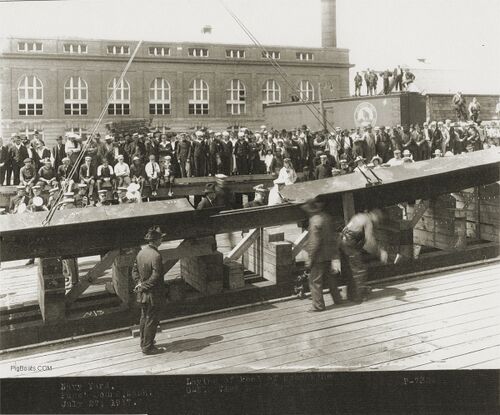
U.S. Navy photo.
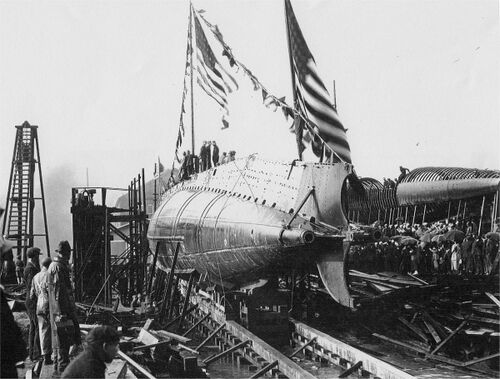
O-2 on launch day May 24, 1918 at Puget Sound Navy Yard. Notice that she is being launched without shafts or props and no stern planes or rudder. From the lighting in the photo it seems to be a late afternoon launch.
The submarine in frame on the right in the photo is the H-6, one of six "H" class submarines being assembled at the same time at the shipyard. These subs had been intended for the Russian Navy and had been built in Canada but the Russian Revolution halted the sale. The U.S. Navy bought them and had them sent to the Puget Sound yard for assembly.
You can also see that it is a bit of a rainy day with a lot of the spectators using umbrellas. If you look at the water under the slipway you can see the rings from the rain hitting the water. The ropes that seem to attach the submarine to the cradle are really to prevent the blocking from floating away once the submarine is floating on its own. The cradle and blocking will be used for the next vessel needing them.
U.S. Navy photo.
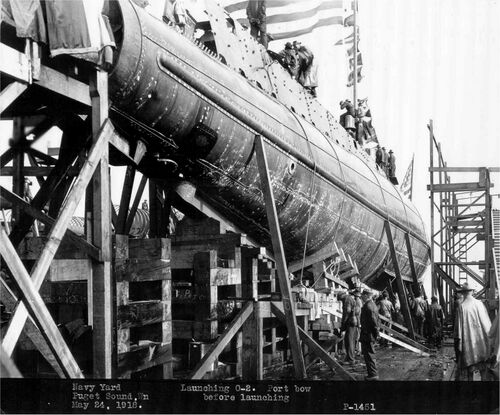
O-2 on launch day May 24, 1918 at Puget Sound Navy Yard. Notice that she is being launched without bow planes and some superstructure plating missing. Also, the torpedo tube bow cap is missing, it should be visible just behind the bunting on the top left. The bottom of the submarine is covered with chalk notations about construction and where to drill. Bisected by the second vertical brace is the Fessenden Oscillator used for underwater communication and identification.
U.S. Navy photo.

Seen under the hull of the O-2 are the submarines H-5 (left) and the H-6 (right) in frame with a workman sitting on the frames of the H-8 to watch the launch of the O-2. Barely seen are two other workmen to the right seen partly through the last opening. One is seen standing below and to the left slightly of the one sitting.
U.S. Navy photo.
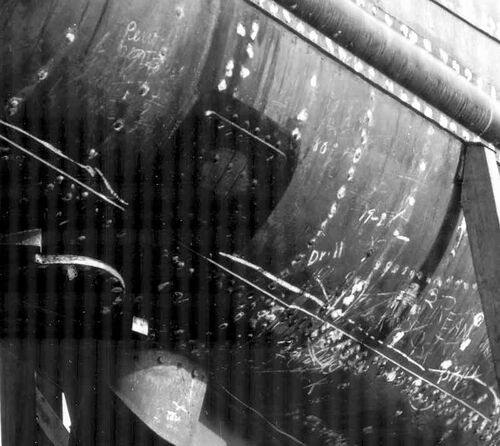
Close-up of the chalk marks on the bottom of the O-2. It seems that an inspector has been checking the rivets and seams prior to launch, an required practice to ensure that the hull is watertight prior to it entering the water.
U.S. Navy photo.

Close-up of the Fessenden Oscillator transducer used for underwater communication and identification. This unit was a predecessor to what became known as SONAR. It was invented in 1912 by Canadian born Reginald Fessenden, who later became a naturalized American citizen, and it was the first of the successful underwater listening device in the USN.
U.S. Navy photo.
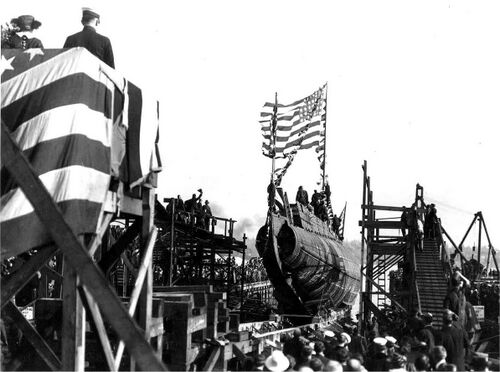
O-2 down the ways on launch day May 24, 1918 at the Puget Sound Navy Yard. Notice that she is being launched without bow planes and some superstructure plating is missing. Also, the torpedo tube bow cap has not been installed. The inner breech doors inside the torpedo room will keep the boat watertight until the bow cap is installed. The submarine's sponsor, Mrs. Francis T. Chew, can be seen atop the launch platform in the top left of the photo. From the lighting in the photo it seems to be a late afternoon launch and the sun has finally broken through as evidenced by the shadows on the submarines hull.
Photo NH 63183 courtesy of NHHC.

O-2 in the water three days after her launching at the Puget Sound Navy Yard, May 27, 1918. Here the final phase of construction, called "fitting out", will begin. The stern is to the left in the photo and bow to the right. Her stern is still light due her not having shafts, props or rudders or stern planes. Her bow is still missing the superstructure plating and bow cap. On the top of the hull can be seen her main induction piping to bring air to her diesel engines, to the left of the gangway plank. The conning tower is to the right of the gangway.
U.S. Navy photo.

Retired CAPT. William C. Eddy sent this information to Ric Hedman:
Back in 1922, I was on the Naval Academy Class Crest Committee and, using a "bows on" photo of the submarine O-2 and adding two dolphins rampant, I came up with a design of the '26 class crest. About two years later, George Meale of Bailey, Banks and Biddle, mentioned that the submarine service was looking for a design for "Submarine Wings" to denote qualification in Submarines. Using my original sketches of the '26 crest, and flattening out the dolphins, we came up with the present submarine insignia which was adopted by the Navy. George gave me what was purported to be the first dolphins struck from the dies, which I gave to my mother. I was very proud to reclaim those original dolphins after qualifying in the 35 boat (i.e. S-35 (SS-140)). The class might be interested in the tie-in between the '26 crest, the O-2, and the present Dolphins.
Logo in the private collection of Ric Hedman.

O-2 and the V-4 (SM-1) in dry dock at the Portsmouth Navy Yard, March 29, 1928. The dry dock is flooding through openings in dry dock doors, at the rear. The huge difference in size between the coastal patrol submarine O-2 and the globe spanning minelayer V-4 is dramatically illustrated here. Only ten years separated their construction.
U.S. Navy photo.
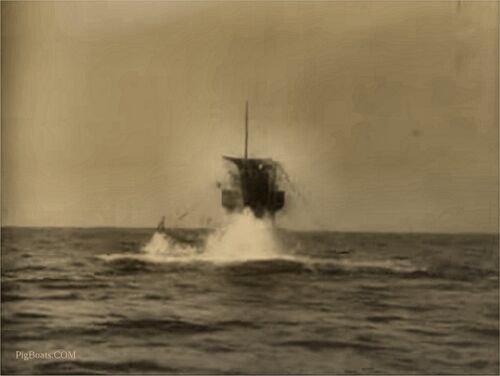
An action shot of O-2 surfacing at the end of a submerged run somewhere in the western Atlantic during WWII.
U.S. Navy photo.
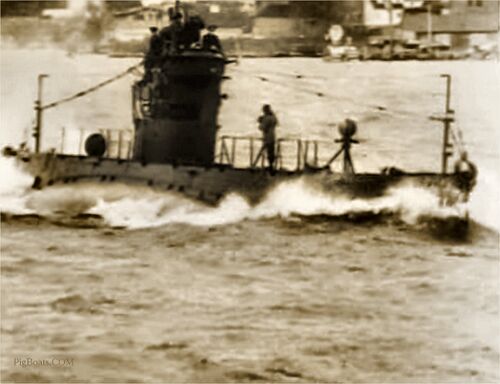
O-2 running on the surface, possibly at the mouth of the Thames River in Connecticut, during the WWII years. O-2 was serving as a training boat for Submarine School students at the base in Groton.
U.S. Navy photo.
-
U.S. Navy photo.
-
Photo 80-G-43874 via NHHC and NARA.
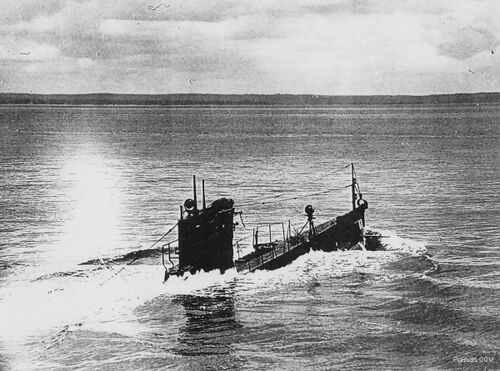
O-2 surfacing after the dive shown in the photos above. To surface, the auxiliaryman in the control room would blow the forward and after group ballast tanks using high pressure air. The bow planesman would set his planes on full rise, and the stern planesman would angle the boat upwards. Once on the surface the bow planes would be rigged in, the engines started and clutched in, and the remaining water in the ballast tanks would be blown out so that the boat would be in full surface trim.
U.S. Navy photo.
Page created by:
Ric Hedman & David Johnston
1999 - 2023 - PigBoats.COM©
Mountlake Terrace, WA, Norfolk, VA
webmaster at pigboats dot com

